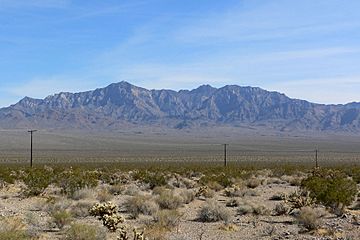Providence Mountains facts for kids
Quick facts for kids Providence Mountains |
|
|---|---|

Providence Mountains from the north
|
|
| Highest point | |
| Peak | Edgar Peak |
| Elevation | 7,162 ft (2,183 m) |
| Geography | |
| Country | United States |
| State | California |
| Region | Mojave National Preserve (Mojave Desert) |
| District | San Bernardino County |
| Range coordinates | 35°1′49″N 115°31′41″W / 35.03028°N 115.52806°W |
| Topo map | USGS Hayden |
The Providence Mountains are a mountain range in the eastern Mojave Desert in California, USA. These mountains are part of San Bernardino County, California. The highest point is Edgar Peak, which is about 7,162 feet (2,183 m) tall.
The Providence Mountains are home to some cool places. These include the Mitchell Caverns Natural Preserve and the larger Mojave National Preserve.
Contents
Exploring the Providence Mountains' Location
The Providence Mountains are located north of Interstate 40. This is a major highway.
Nearby Mountain Ranges
Other mountain ranges are close by. The New York Mountains are to the northeast. The Clipper Mountains are to the southeast. To the southwest, you can find the Granite Mountains, Pisgah Crater, and the Bullion Mountains.
Nearby Towns
The mountains are southeast of a small town called Kelso. They are also east of Ludlow. To the northwest, you'll find Essex and Goffs.
Nature in the Providence Mountains
The Providence Mountains have different types of plant life. This depends on how high up you go.
Plants at Lower Elevations
At the lower parts of the mountains, the plants are suited for dry, desert conditions. You'll see plants like:
- Creosote bush (Larrea tridentata)
- California Barrel Cactus (Ferocactus cylindraceus)
- Joshua trees (Yucca brevifolia)
- Mojave yucca (Yucca schidigera)
Plants and Animals at Higher Elevations
As you go higher than 4,000 feet, the habitat changes a lot. This area is like a "sky island." It gets more moisture, which helps many animals and plants grow.
Here, you can find small forests of:
- Single-leaf Pinyon (Pinus monophylla)
- California Juniper (Juniperus californica)
There are also areas with chaparral and woodlands. These have Oaks (Quercus turbinella) and Manzanita plants.
Unique Insects in Mitchell Caverns
Mitchell Caverns is a special place. It is home to two types of insects that live nowhere else in the world. These are called endemic species.
History of the Providence Mountains
The Providence Mountains have a long and interesting history.
Early Inhabitants: The Mojave People
For thousands of years, the Mojave people lived in this area. It was their homeland.
Spanish Explorers
In the late 1700s, a Spanish explorer and missionary named Francisco Garcés traveled through the Mojave Desert. He was part of an expedition from Sonora to Monterey Bay. Garcés traveled with the Mojave people. He called the Providence and New York Mountains together the Sierra de Santa Coleta. He saw them as one large mountain range. Garcés passed through Cedar Canyon, which is a path between the New York and Providence Mountains. This path was part of the old Mohave Trail.
How the Mountains Got Their Name
In the 1800s, pioneers traveled along the Mojave Road. They found springs and streams in these mountains. They were so thankful for the water that they "thanked Divine Providence." This is how the mountains got their current name.
Mining History
People found silver in the mountains. Because of this, the Rock Springs Mining District was started in April 1863. The Macedonia Mining District followed in September 1864. Mining has continued in different areas of the mountains for over a hundred years.
Becoming a National Preserve
In 1994, the Providence Mountains became part of the Mojave National Preserve. The National Park Service now protects the area. They also help people enjoy it for recreation.


